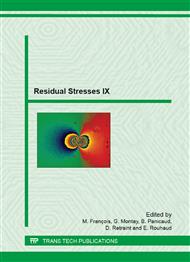[1]
K. Hulka, A. Kern, U. Schriever, Application of Niobium in Quenched and Tempered High-Strength Steels, Mater. Sci. Forum 500-501 (2005) 519–526.
DOI: 10.4028/www.scientific.net/msf.500-501.519
Google Scholar
[2]
Y. Nie, C. Shang, Y. You, X. Li, J. Cao, X. He, 960 MPa Grade High Performance Weldable Structural Steel Plate Processed by Using TMCP, J. Iron Steel Res. Int. 17 (2010) 63–66.
DOI: 10.1016/s1006-706x(10)60061-1
Google Scholar
[3]
M. Klein, H. Spindler, A. Luger, R. Rauch, P. Stiaszny, M. Eigelsberger, Thermomechanically Hot Rolled High and Ultra High Strength Steel Grades - Processing, Properties and Application, Mater. Sci. Forum 500-501 (2005) 543–550.
DOI: 10.4028/www.scientific.net/msf.500-501.543
Google Scholar
[4]
R.Y. Chen, W.Y.D. Yuen, Oxide-Scale Structures Formed on Commercial Hot-Rolled Steel Strip and Their Formation Mechanisms, Oxidat. Metal. 56 (2001) 89–118.
Google Scholar
[5]
P. Sahoo, T. Debroy, M.J. McNallan, Surface Tension of Binary Metal - Surface Active Solute Systems under Conditions Relevant to Welding Metallurgy, Metall. Mater. Trans. B 19 (1988) 483–491.
DOI: 10.1007/bf02657748
Google Scholar
[6]
Y. Zhao, H. Zhou, Y. Shi, The study of surface active element on weld pool development in A-TIG welding, Model. Simul. Mater. Sci. Eng. 14 (2006) 331–349.
DOI: 10.1088/0965-0393/14/3/001
Google Scholar
[7]
S. Lu, H. Fuji, K. Nogi, Marangoni Convection and Gas Tungsten Arc Weld Shape Variations on Pure Iron Plates, ISIJ Int. 46 (2006) 276–280.
DOI: 10.2355/isijinternational.46.276
Google Scholar
[8]
C.R. Heiple, J.R. Roper, R.T. Stagner, R.J. Aden, Surface Active Element Effects on the Shape of GTA, Laser, and Electron Beam Welds, Weld. J. 62 (1983) 72s–77s.
Google Scholar
[9]
C.R. Heiple and J.R. Roper, Mechanism for Minor Element Effect on GTA Fusion Zone Geometry, Weld. J. 61 (1982) 97s–102s.
Google Scholar
[10]
T. Nitschke-Pagel and H. Wohlfahrt, Residual Stresses in Welded Joints - Sources and Consequences, Mater. Sci. Forum 404-407 (2002) 215–226.
DOI: 10.4028/www.scientific.net/msf.404-407.215
Google Scholar
[11]
EN 1011-1, Welding - Recommendation for welding of metallic materials - Part 1: General guidance for arc welding, (2007).
DOI: 10.3403/30158904
Google Scholar
[12]
EN 1090-2, Execution of steel structures and aluminium structures - Part 2: Technical requirements for steel structures, (2008).
DOI: 10.3403/30132922
Google Scholar
[13]
B.T. Alexandrov and J.C. Lippold, Single Sensor Differential Thermal Analysis of Phase Transformations and Structural Changes During Welding and Postweld Heat Treatment, Weld. World 51 (2007) 48–59.
DOI: 10.1007/bf03266608
Google Scholar
[14]
T. Nitschke-Pagel and H. Wohlfahrt, The Generation of Residual Stresses due to Joining Processes, in: V. Hauk, H. Hougardy, E. Macherauch (Eds. ), Residual Stresses – Measurement, Calculation, Evaluation, DGM Informationsgesellschaft mbH, 1991, pp.121-133.
Google Scholar


